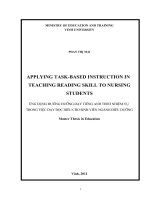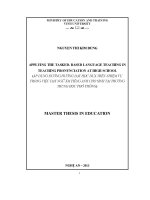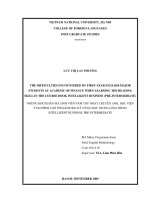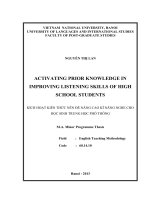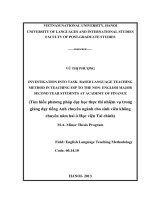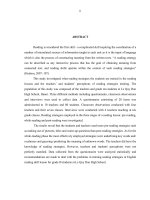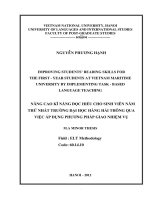SKKN AN INNOVATION IN APPLYING TASK – BASED LANGUAGE TEACHING APROACHES IN DEVELOPING SPEAKING COMPETENCE FOR HIGH SCHOOL STUDENTS
Bạn đang xem bản rút gọn của tài liệu. Xem và tải ngay bản đầy đủ của tài liệu tại đây (2.64 MB, 44 trang )
BM 01-Bia SKKN
S GIÁO D C VÀ
:
OT O
NG NAI
ghi)
AN INNOVATION IN APPLYING TASK
BASED LANGUAGE
TEACHING APROACHES IN DEVELOPING SPEAKING COMPETENCE
FOR HIGH SCHOOL STUDENTS
Ng
i th c hi n:
-
BM02-LLKHSKKN
I.
1.
2.
3.
4.
18 /09/ 1975
Nam
2
-
5.
(CQ)/
(NR);
0948636878
6. Fax:
E-mail:
7.
8.
:
9.
ong
II.
-
2011
III.
-
-
2
School Year: 2016
2017
ACTION RESEARCH
Research Title:
AN INNOVATION IN APPLYING TASK
BASED LANGUAGE TEACHING
APROACHES IN DEVELOPING SPEAKING COMPETENCE FOR HIGH SCHOOL
STUDENTS
3
ACKNOWLEDGEMENTS
master of Le Hong Phong high school, the school managing board and all of
the teachers in English group as well for their meaningful supports of spirit
for the implement of the research and innovation.
I am grateful to my two helpful colleagues who helped me with guiding
I am grateful to the teachers and students in
Last but not least, I am grateful my dearest students in two classes 11B2
and 11B5, who took part in the research enthusiastically.
4
AN INNOVATION IN APPLYING TASK
TEACHING
APROACHES
IN
BASED LANGUAGE
DEVELOPING
SPEAKING
COMPETENCE FOR HIGH SCHOOL STUDENTS
ABSTRACT
This eight week bottom
of using Task
up process innovation was to find out the effect
based language teaching (TBLT) in improving speaking
competence of Le Hong Phong high school students, in Bien Hoa, Dong Nai
province. The innovation was implemented from October 3 rd to November
26th , 2016 (see the appendix A). It was based on the problem solving model
(Markee, 1997 p.66), in which the researcher working as an implementer and
an inside change agent used the comparisons of pre test and final
test
results between two classes 11B2 and 11B5, class room observation records,
interviews and feedback questionnaires. Two of the
acted as insides change agents and implementers. And ninety
two students
in two classes participated in the innovation (potential adopters or resisters).
I. INTRODUCTION
English has been one of the compulsory subjects to secondary and high
school students in Vietnam in the last fifteen years. Students have to spend at
least three classes a week to study English. It is one of six subjects included in
the GCSE examination which high school students have to pass to finish their
hig
86.8% of the students
graduating from high school admit that they are not be able to communicate
in English even if using simple sentences. Even the students who passed
university entrance examination of English branch feel it difficult to contact
parents and teachers a lot, so there have been many attempts to enhance
he adoption of
5
skills. However, teaching speaking and listening at high schools still does not
meet the required aim. This fact arouses us the view of applying Task
Based
Language Teaching (TBLT), an approach of Communicative Language
Teaching (CLT), in redesigning the tasks in the official textbooks with the
hope to help students in Vietnamese context in general and in LE HONG
PHONG high school in Dong Nai province in particular study English in
communicative ways.
So as to get any accomplishment, the researcher, however, has to
encounter many problems. Firstly, The Grammar Translation Method (GTM),
known as traditional method, has been applied in Vietnam for ages. They
have paid more attention to teaching grammar than teaching speaking or
listening. As the result of that, students may find it very difficult to talk with
other people in the target language. Moreover, Vietnamese educational
system is deeply influenced by Confucianism (teacher
centered). Students
become more and more passive in class and dare not to ask teachers what they
new English series textbooks are
written for teaching 4 skills: Reading, Speaking, Listening, and Writing, both
teachers and students feel hard to teach and study speaking and listening
because of time limitation. Thus, teachers sometimes neglect the speaking and
listening sections to concentrate on grammar, reading so that their students
can pass the examinations which only test their writing, grammar points and
vocabulary memorable competences.
Thirdly, there are often over forty
students in one class, it is also a problem in teaching by using communicative
skills. In addition, despite the comparatively high-level understanding of
TBLT concepts, many teachers actually hesitate to adopt TBLT as an
instructional method in classroom practice. This may result from the fact that
most of the teachers still use the traditional lecture-oriented methods, which
they are accustomed to, and more than that, they have the psychological
6
pressure of facing some new disciplinary problems in using TBLT. Then the
main research questions arise:
1.
speaking skill?
2. What
English?
II. DEFINITIONS OF TERMS
Definitions of task: According to Nunan (1989),communicative task is
manipulating, producing or interacting in the target language while their
-based curriculum, then, specifies what a learner
needs to do with the English language in terms of target tasks and organizes
Prabhu (1987,
outcome from given information through some process of thought, and
which allow
As can be seen,
these definitions are somewhat different; they all emphasize the fact that
attention is focused on meaning rather than grammatical form.
Task - based language Teaching framework: Jane Willis (1996)
designed TBLT framework consists three main phases: pre-task, task-cycle,
and language focus. At pre-task phase, teacher introduces topic and task, and
students get exposures of linguistic chunks. The task cycle phase can be
subdivided into three task stages, including task stage, planning stage, and
report stage. This is considered the main task phase in which students use
the target language the most to finish task requirements. The last phase is
language focus. In this phase, teacher helps learners to improve linguistic
7
phase.
The Researcher: the researcher is the main person who conducted the
innovation of applying TBLT in teaching English in Le Hong Phong high
school in Dong Nai province.
: There were two colleagues of the
researcher participating in the innovation. One offered himself as an
interviewer who interviewed the experimental group. The other was an
interviewer who interviewed the control one. These two colleagues also
observers in classroom observation of this research.
The Students: The students in the innovation are in grade 11. Most of
them have studied English, at least, for 6 years from grade 6 to grade 11.
As can be seen, schools in Vietnamese educational system are divided
into three groups: elementary school (from grade 1 to grade 5), secondary
school (from grade 6 to grade 9) and high school (from grade 10 to grade
12).
To students at high school, English is a compulsory subject and it is
taught three periods or more a week.
III. LITERATURE REVIEW
1. The literature review of Task based Language Teaching:
Task-based language teaching can be considered one particular
2004, p.1). In other words, it is a communicative approach to language
teaching, using the successfu
primary organizing principle. With the approach of the communicative
language teaching approach in the early 1980s and much emphasis on
commonly use in the field of second language acquisition in terms of
8
developing process-oriented syllabi and designing communicative tasks to
-based view of language
teaching, based on the constructivist theory of learning and communicative
language teaching methodology, has evolved in response to some limitations
of the traditional PPP approach, represented by the procedure of
presentation, practice and performance (Ellis, 2003, Long & Crookes, 1992).
The P-P-P approach has a communicative focus; however, error correction is
an important part of this method. Early models of Communicative Language
Teaching often used functional units of organization and practiced to swap
grammatical features. Today, emphasis is on the unit of task rather than on
the unit of function or practice (Richards & Renandya, 2002, p. 94). A unit
of task refers to an activity where students use their own available language
resources which in the end lead to a real outcome. Examples of a unit of task
can involve playing games or sharing and comparing experiences. In a unit
of task the students are to take part in different processes within the task
such as negation of meaning, paraphrasing and experimentation. If students
take part in these units of task the results lead to successful language
development (p. 94). Thus, it has the substantial implication that language
learning is a developmental process promoting communication and social
interaction rather than a product acquired by practicing language items and
that learners learn the target language more effectively when they are
naturally exposed to meaningful task-based activities. Such a view of
language teaching led to the development of various task-based approaches
in the eighties (Breen, 1987; Candlin & Murphy, 1987; Nunan, 1989 &
Prabhu, 1987), and during the nineties has developed into a detailed
practical framework for the communicative classroom in which learners
perform task-based activities through cycles of pre-task preparation, task
performance and post-task feedback through language focus (Skehan, 1996
& Willis, 1996). TBI views the learning process as a set of communicative
9
tasks that are directly linked to the curricular goals they serve (Brown,
1994).
2. The literature review of Innovation:
According to Markee (1997), Innovation and change were variously
treated by writers. Some considered them different processes, others thought
these were synonymous. He added that:
innovation is
a species of the genus change, in which change is an ongoing, almost unconscious
process that involves reworking familiar elements into new relationships;
innovation on the other hand, is a willed intervention, which results in the
development of ideas, practices, or beliefs that are fundamentally new (Miles
1964; A. Nicholls 1983). I accept that innovation in education should be a
is an
orientating attempt to treat the problems in a particular context so that some better
success could be made by applying a new method of teaching. Although the
innovation expects to be succeeded, it sometimes fails in applying. In this case, the
implementer needs to investigate why it does not work and what is needed to make
it success.
3. Cultures and innovation:
Cultures play a very important role in innovation. As Tudor (2001) noted
that:
erful role in
guiding their behaviours in the classroom as well as their evaluation of the actions
and behaviours of other participants. The second is that participants may not be
explicitly
aware of the principles on which they are operating. Their culture of
learning may thus constitute a powerful but potentially - hidden agenda, one
(Tudor, I., 2001. p 158)
Basing on this, the implementer needs to know about his students in the
classroom and what is happening among them so that he can treat them with a
10
deeply influenced by Confucian culture, it means that teacher
centered. Students
study in a quiet and passive environment, keeping silent and listening to their
teacher. This is, of course, not fit for a communicative language class. Therefore,
the implementer should do something to deal with the difference. In short, In order
to get innovation, the implementer should both teach and find out the classroom at
the same time.
4. Successful or unsuccessful Innovation:
An innovation may be successful or unsuccessful, which depends on many
factors. Shamin (1996) stated that a successful or unsuccessful innovation is up to
various factors impacting it at different stages and levels. While Markee (1997)
potential adopters, characteristics and strategies used for managing planned
changes in certain contexts. Lee (2001) argued that how teachers as the end users
of an innovation consider its feasibility is an important factor in evaluating the
final success or failure of that innovation. Meanwhile, Tinguo (2002) commented
that there is no approach of management which could give a perfect explanation
for successful management of change. It varies from individual to individual, so
we should take different approaches to cope with different problems.
IV. INNOVATION IMPLEMENTATIION
1. Roles of stakeholders:
Stakeholders are those who are involved in an innovation that takes up in a
certain social system (Miles 1964 p.13
18). Each of them has their own point of
view on education. As Roger (1983), innovation in schools occurs in a finished
organization. And in considering about stakeholders of an innovation, Lambright
and Flynn (1980) remarked that stakeholders are regarded as adopters or resisters,
clients, implementers, suppliers and change agents. All of them relate to each other
in an innovation.
a.
Adopters:
11
Markee (1997 p.58) outlined five different types of adopters of an
innovation based on the diffusion curve. They are innovators, early adopters, early
majority, late majority and laggards. In the light of this, the adopters of this
innovation can be seen that the researcher, two teachers who were invited to join
the innovation, students in two 11 grade classes in Le Hong Phong high school.
b.
Resisters:
Resisters are those who opposite to adopting the ideas from the change
agents and unwilling to change. In this innovation, there were some students in
these two classes who resisted the innovation.
c.
Implementers and suppliers:
Implementers are someone that implements the innovation; in this case, they
are the researcher and his two colleagues. They also play roles of suppliers because
they supplied the relevant materials.
d.
Clients:
Clients are those who are affected by the change. Here are students in two
classes.
e.
Change agents:
Change agents are people who provide support for change. The change
agents in this innovation are the researcher, his two colleagues and the head
master.
2. Model of Innovation:
This innovation is a bottom
up process. It is problem
solving model
because the idea of action research innovation came from the teachers who were
known as inside change agents. They were those who were responsible for the
change. The researcher and his two colleagues recognized the problem in
communicative skills of their students and they wished to solve it.
V. METHODOLOGY:
1. Background:
a. The school and the English group:
12
This research was carried out to investigate whether TBLT could help
students at Le Hong Phong (LHP) high school improve their English
approach. It was executed at LHP high school, a small school located Bien Hoa
town, Dong Nai Province, South Vietnam. There are ten teachers of English in the
language group of this high school. Seven of them graduated from college. Two of
them including the researcher had a post-graduate diploma in TESOL. The last one
took Master in TESOL already.
b. The syllabus design and its cultural context:
Generally, the textbooks used to teach in grade 11 consisted of 16 units. It
was designed by The Vietnamese Ministry of Education and Training. The
duration time for each unit is 5 periods (one period lasts forty _ five minutes). Each
unit has five parts: reading, listening, speaking, writing, and language focus; which
are corresponded to 5 periods. There are 3 prescribed English studying periods per
week. Some high schools can hold some more extra periods per week if necessary.
In order to implement TBLT, the researcher had to have extra curricular
communicative activities in eight weeks (2 extra periods a week) from the 3th of
October to the 26th of November, 2016.
c. The rationale behind the innovation:
As mentioned above, The Vietnamese Ministry of Education and Training
(MOET) reformed new English textbooks for high school students six years ago. In
these textbooks, students are asked to do tasks to improve all of the language skills.
However, the tasks in the textbooks might be considered structure and grammar focused tasks. In speaking tasks, for instant, they mainly focus on the development
of reading the dialogues in the textbook, practicing the given conversations, doing
some substitution chains, etc. They are not interesting and real - life tasks. For
these reasons, it seems that an innovation of extra
curricular speaking activities
should be applied. Therefore, the researcher explained to students about the
curricular and most of them agreed to join it.
13
d. Participants of the research:
Students:
The research was carried out with 92 students from two classes at LHP high
school. They are at grade 11. One class is 11B2 with 46 students (36 females and
10 males). The other is 11B5 with 46 students (32 females and 14 males). Their
ages are approximately 16 years old. They all study English as a compulsory
subject at high school. After conducting a quick survey with these students, the
researcher realized that 68 of them had studied English because they wanted to
pass their exams. The remaining 24 students had studied English because they
want to use the language for their real life and for their future study or for future
job orientation. The learning target of these 24 students is clearly determined so
their motivation was much stronger.
These two classes were not randomly chosen, in fact, the researcher was in
charge of teaching them at school. This might cause problem with the validity and
the reliability of the results of the research.
Teachers:
Two teachers were invited to teach these two classes. One teacher (Teacher
A), who had a Master in TESOL granted by Victoria University, Australia, was in
charge of class 11B2 (experimental group). The other (Teacher B), who had a postgraduate diploma in TESOL, was in charge of class 11B5 (control group). Teacher
A is 43 years old. He has been teaching English at LHP high school for 6 years (he
had taught English in other high school for 6 years before he came to teach at
LHP). He is also an expert in applying TBLT for teaching speaking. Teacher B is
35 years old. He has been teaching English at LHP high school for 10 years.
However, he seldom uses TBLT in teaching.
2. Stages of the innovation, finding and analyses:
2.1.
Pilot study:
* The questionnaire for feedback after learning of students:
The researcher sent the questionnaire (see the appendix G) to three experienced
speaking teachers who did not participate in the study to check for its validity. Two
14
of them have been teachers of English at
Dong Nai for 12 years. Only the items which were accepted by two of three
teachers or by three of them were left in the questionnaire. After their approval of
the items, the researcher sent the questionnaire to ten students including task based
reliability.
* Pretest and posttest topics:
The pretest and posttest were sent to the three mentioned-above teachers to
check for the validity. The researcher asked ten students including task - based
students and non task to check for the reliability.
* The classroom observational checklist:
In the same vein, the classroom observation checklist was sent to the three
teachers as mentioned above before to check for the validity. After that, the
researcher used this classroom observation checklist to observe two periods, one
for task
based class and one for non task
based class at
check for the reliability.
* The interview questions for students:
The interview questions for students which consists of five questions to find
TBLT were sent to these three teachers for valid check and then they were used to
2.2. Procedures:
Pretest: After talking to ninety- two students in class 11B1 and class
11B12 students about the research, the researcher let them do the pretest in order to
find out the speaking competence among students in these two classes, the gap in
their knowledge. How well they performed on their speaking before treated TBLT.
The results of the pre-test were compared with the results of the posttest to
discover the various improvements among task
based and non task
based
15
students during the time of the research. The researcher collected twelve
representative students from each class. Those who had noticeably different marks,
four of the students got under 3 marks from their test. The other four got under 5
marks and the remains reached over 5 marks. These two twelve student groups
were regarded as representatives of two classes. Therefore, they were paid much
attention to during the research. Their pretest results were compared with the
results of the posttest at the end of the research.
The pretest was marked by two examiners at the same time (the researcher
and the teacher who was in charge of these classes). The test consisted two parts.
In the first part, students selected a sheet of paper with a topic written on it. They
had to speak for two minutes on this topic. They could not ask for another topic.
They were given one minute to write down their ideas. A sheet of paper and a pen
are provided. Once they finished their two minutes, the examiners stopped students
and then asked them some questions on what they had talked about. The second
part lasts a total of 3-4 minutes. The students were marked on fluency, vocabulary,
grammar, pronunciation and ideas. (see the topics in Appendix B)
Posttest: After eight weeks of the research, students of these two classes did
the post test. The post test was carried out in the same process with the pretest. In
fact, the topics in the two tests were absolutely same.
Finding and Analyses:
Table 1:
CLASS 11B2
No.
Pre test Result
Posttest Result
FOUR STUDENTS GOT FROM 1 TO 3 MARKS AT THEIR
PRETEST
1
A2
2
5
16
2
B2
1
4
3
C2
2
6
4
D2
3
6
FOUR STUDENTS GOT FROM OVER 3 TO 5 MARKS AT THEIR
PRETEST
5
E2
4
6
6
F2
5
7
7
G2
5
8
8
H2
4
7
FOUR STUDENTS GOT FROM 5 AND MORE MARKS AT THEIR
PRETEST
9
I2
6
8
10
J2
7
9
11
K2
6
7
12
L2
8
9
9
8
7
6
5
Pre- Test
4
Final - Test
3
2
1
0
A2B2C2D2E2F2G2H2I2 J2K2L2
17
Table 2:
IN CLASS 11B5
No.
Pre test Result
Posttest Result
FOUR STUDENTS GOT FROM 1 TO 3 MARKS AT THEIR PRETEST
1
M5
2
3
2
N5
1
2
3
O5
1
3
4
P5
3
4
FOUR STUDENTS GOT FROM OVER 3 TO 5 MARKS AT THEIR
PRETEST
5
Q5
4
4
6
R5
5
6
7
S5
5
5
8
T5
4
5
FOUR STUDENTS GOT FROM 5 AND MORE MARKS AT THEIR
PRETEST
9
U5
6
7
10
V5
7
7
11
W5
6
7
12
X5
8
8
18
8
7
6
Pre- Test
5
Final - Test
4
3
2
1
0
M5N5O5P5Q5R5S5T5U5V5W5X5
19
X5
L2
W5
K2
V5
J2
U5
I2
T5
H2
S5
G2
Posttest
R5
Pretest
F2
Q5
E2
P5
D2
O5
C2
N5
B2
M5
A2
0
5
10
20
As can be observed from the charts above, most of the students got some
progresses, some got much and other got little. However, the students in class
11B2 (treated with TBLT) seemed to be a bit better than students in class 11B5
(Non - TBLT treated
speaking competence in some way.
* Classroom observation:
As mentioned above, two teachers were invited to teach these two classes.
Teacher A taught class 11B2 with task - based approaches. He redesigned the
speaking tasks in grade 11 textbook as three stages of TBLT and helped students
apply it. Teacher B taught class 11B5, using the tasks in grade 11 textbook, with
grammar
translation method, such as, repeat the model dialogs, practice reading
available conversations, substitution change. The teacher commonly focused on
grammar, sentence structures that appeared in the tasks in textbook.
Findings and analyses:
The researcher randomly observed four out of sixteen periods in each class. The
researcher used classroom observation checklist (Appendix C) to collect data and
found out. Below are two trial periods, one at each class in detail:
Class 11B2:
In this class, the TBLT framework was applied in teaching
speaking (Appendix E). Teacher A has redesigned the tasks with
his own materials Instead of using tasks in the textbook. In the
pre-task 1, teacher explores the topic language and then giving
students some input about how to start a conversation with
strangers. In the while-task, teacher asked students to go around,
greet other people, and ask them about their hobbies. While
students were doing the task, teacher A went around, gave his
students a hand and took note the mistakes made by students as
well. In the post task, he called some pairs to perform the task in
comments and corrected some of their mistakes.
21
After that, they went to task 2. In order to begin, teacher helped students
recall and activate the process of opening by explaining the situation (let them
work as researchers). In the while-task, students worked in group of four or five.
First, every of them had to go around and interview their classmates with
suggested questions in the interview paper (handout in Appendix E). Then students
worked in their group, comparing the results they got from the interview and
decide which kind of shops they were going to open. During the task, teacher went
around and helped students to solve some of their difficult problems or suggested
some ideas. And in the post task, teacher randomly chose two groups to report the
plan to the whole class. After their reports, teacher gave feedback about their work.
In this class, it could be seen that students were very interested in doing the tasks.
They could practice their speaking skill freely based on tasks. Moreover, the tasks
used were realconstitutes 75% of the speaking class. This proved that TBLT could help to enable
students in using the target language in both classroom and real life context.
Although there were many advantages in applying TBLT in teaching, we did
have to face some problems. The first one might be the noise. In this kind of
teaching, students often make noise when they go around the classroom and
discuss in groups. The second one was the classroom management. In spite of the
on in each group due to large size class. And one more problem was that the
students who were talkative seemed to dominate the group or the pair works,
which makes some shy or low
ability students keep being silent during the
speaking period.
Class 11B5:
In this class, teacher B used the tasks in the textbook (see the teaching plan
in appendix D). There was still communication in class, but it was too little. As the
structure of the tasks in the textbooks, there were also three phases for each task:
the pre-speaking, while- speaking and post-speaking. In task 1, teacher asked
22
students to read aloud the dialogue in the textbook at first. Then, students worked
in pairs and took turn to ask and answer the questions using the information from
the table. After this task, teacher asked students to report back and gave feed back
other and with the teacher, but not much. The lacking of the communicative
elements in this task because there was no information gaps in the textbook. In
fact, there were no challenges in this task because all students knew the answer.
Some of the students did not want to do the task, and some others chatted with
each other in Vietnamese. And in the post-task stage, students just did the
substitution chains based on the sample dialogue in the text book, which was not
actually what happened in real life.
Going to task 2, the teacher asked students to work in groups and take turn
to talk about the sports results of Vietnamese athletes at 14th Asian Games. There
were no communicative elements, too. Therefore, students had no interest and took
no notice of what was happening in class.
* Short questionnaire for feedback after learning of students:
After eight week of the research, ninety
two short questionnaire papers
were sent to all of students in these two classes (11B2 & 11B5) in order to get their
opinion about the effects of learning during the research duration in improving
their speaking abilities (Appendix G).
ing periods
Table 3:
Very interesting Interesting
Normal
Boring
11B2
32.60%
58.70%
8.70%
0%
11B5
0%
6.52%
26.08%
67.40%
As can be seen from above table, 67.40% of students in class 11B5 felt
bored in comparison to 0% of students in class 11B5. Moreover, 91.30 % of
students in the first class, felt interested in the second period while there were only
6.52 % of students in the second class. This proves the effect of TBLT in
23
motivating students in the speaking class, which makes students feel interested in
speaking.
Table 4:
Class 11B2
Very interesting
Interesting
Normal
Boring
30.43%
65.22%
4.35%
0%
0%
0%
32.61%
67.39%
Period 11B5
speaking class. It showed that no one felt interested in the tasks in the textbook.
The tasks in the text book made students (67.39%) feel bored, while 95.65% of
students were fond of the tasks applying the TBLT. It can be explained that in
TBLT students often have opportunities to create, choose what they should do to
finish the tasks themselves, which leads to the success of the speaking tasks.
Table 5:
Difficult
Suitable
Easy
Class 11B2
2.17%
76.09%
21.74%
Class 11B5
0%
63.04%
39.96%
From the above results, we can learn that the speaking tasks in the textbook
seems to be easy with 39.96% of students choose this option; and there was no
students in class 11B5 felt it difficult in doing the tasks. However, the tasks with
the implementation of TBLT seem to be more challenging to students. It requires
- ability
students.
Table 6:
Yes
Sometimes
No
24
Class 11B2
78.26 %
10.87 %
10.87 %
Class 11B5
89.13 %
6.52 %
4.35 %
clear as in non- TBLT class (78.26 % in comparison with 89.13 %). It should be
noticed that, in the second class, the instructions were available in the textbook,
moreover the tasks were also very simple, so it was very easy for them to follow
context, and explained the roles, so it might confuse the students. This suggested
that teacher in TBLT class should pay more attention about explaining the tasks so
that they are clear enough for the students to follow.
Table 7: Communication in the class
Very much
Much
Little
Class 11B1
21.74 %
52.17 % 26.09%
0%
Class 11B5
2.17%
41.31%
2.17%
54.35%
None
As can be seen from the table 7, in the first class, 73.91 % of students felt
that they could use the target language to talk to their friends. This number is larger
than that of the second class (43.48 %). From this result, we can learn that TBLT
their classmate.
Table 8: The practicability of the tasks
Yes
No
Class 11B2
100 %
0%
Class 11B5
26.09 %
73.91 %
From this table, it is very convincingly to see that 100% of students found
the tasks in the first class very useful for them in the real life. However, the task in
25

